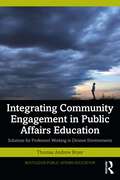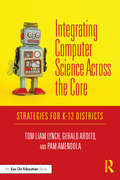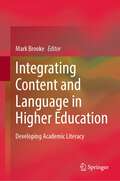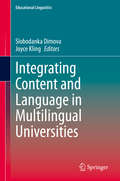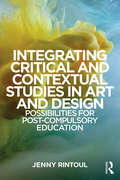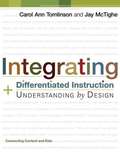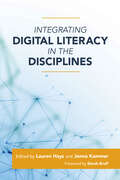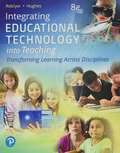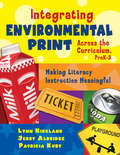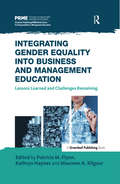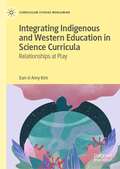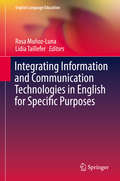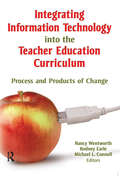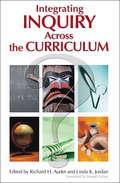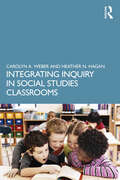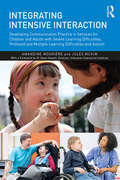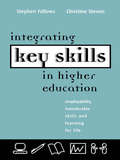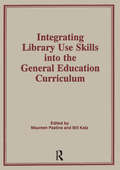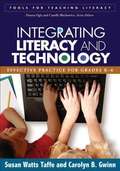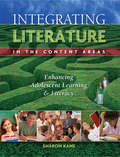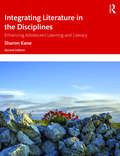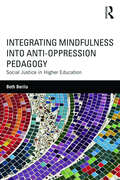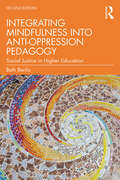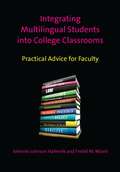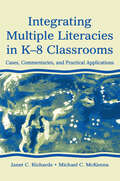- Table View
- List View
Integrating Community Engagement in Public Affairs Education: Solutions for Professors Working in Divisive Environments (Routledge Public Affairs Education)
by Thomas Andrew BryerCommunity engaged universities prepare students to participate in societies in ways that are inclusive. This book presents a coherent argument for higher education institutions not only to encourage students to engage in their communities, but also to develop themselves as community engaged institutions. Analyzing the design and implementation of community engaged teaching and learning practices, author Thomas Bryer explores training in democratic practices and envisions a future in which higher education institutions are better prepared to cope with democratic backsliding.Teaching and professional development cases are woven throughout—developed, adapted, and enhanced by the author over a period of years—and grounded in the great debates happening today. Integrating Community Engagement in Public Affairs Education is a culmination of multiple years of experimentation with different approaches to teaching future and practicing public sector leaders the tools of democratic engagement. The text is grounded in a case‑based design that spans undergraduate, Master’s, and Ph.D. students, as well as local government managers, offering concrete examples of teaching and learning strategies that promote public value and measurable social impact. The book closes with practical strategies for publicly engaged scholars to effectively educate the next generation of students about democratic engagement within divided communities. It will be required reading for public administration faculty, as well as practicing public administrators and those who provide training to them.
Integrating Computer Science Across the Core: Strategies for K-12 Districts
by Tom Liam Lynch Gerald Ardito Pam AmendolaIntegrating Computer Science Across the Core is a guide to systematizing computer science and computational thinking practices in your school. While most books explain how to teach computer science as a stand-alone discipline, this innovative approach will help you leverage your existing curriculum to deepen and expand students’ learning experiences in all content areas. Effective, equitable, and sustainable, this blueprint provides principals, curriculum directors, directors of technology, and other members of your school or district leadership team with suggested organizational structures, tips for professional learning, and key resources like planning instruments.
Integrating Content and Language in Higher Education: Developing Academic Literacy
by Mark BrookeThis book presents research initiatives by tutors involved in a content-based instruction context as part of the University Town writing programme, National University of Singapore, which is an interdisciplinary programme designed to teach first- and second-year undergraduate students how to conduct academic research and write evidence-based research papers. It presents research the tutors conducted within the dual fields of teaching discipline-specific content and developing students’ academic literacy. The book focuses mainly on pedagogy and material development in this context. It shares the tutors' scholarship of teaching and learning experiences from this programme through presenting action research from the classroom, demonstrating constructive cycles of praxis, which are then evaluated using student texts and student feedback. The book draws on academic research literature related to content-based instruction, as well as topics such as facilitating collaborative peer reviews of assignments, and critical thinking pedagogy. It covers how multi-disciplinary or multi-lingual classrooms of this genre can motivate students to conduct and write up research and provides an overview of how both content and academic literacy is combined at a high level of engagement from an Asian context.
Integrating Content and Language in Multilingual Universities (Educational Linguistics #44)
by Slobodanka Dimova Joyce KlingThis volume provides conceptual syntheses of diverging multilingual contexts, research findings, and practical applications of integrating content and language (ICL) in higher education in order to generate a new understanding of the cross-contextual variation. With contributions from leading authors based in Asia, the Middle East, and Europe, the volume offers comparison of contextualized overviews of the status of ICL across the geographic areas and allows us to identify patterns and advance the scholarship in the field. ICL in teaching and learning has become an important consideration in the endeavors to address linguistic diversity at universities, which has resulted from the growing teacher and student mobility around the world.
Integrating Critical and Contextual Studies in Art and Design: Possibilities For Post-Compulsory Education
by Jenny RintoulIntegrating Critical and Contextual Studies in Art and Designexamines the relationship between two aspects of art education that appear at times inseparable or even indistinguishable, and at others isolated and in conflict: Critical and Contextual Studies (CCS) and studio practice. Underpinned by international contexts, this book is rooted in British art and design education and draws upon contemporary case studies of teaching and learning in post-compulsory settings in order to analyse and illustrate identities and practices of CCS and its integration. The chapters in this book are divided into three sections that build on one another: 'Discourse and debate'; 'Models, types and tensions'; and 'Proposals and recommendations'. Key issues include: knowledge hierarchies and subject histories and identities; constructions of 'theory' and the symbiotic relationship between theory and practice; models and practices of CCS within current post-compulsory British art and design education; the reification of ubiquitous terms in the fields of art and design and of education: intuition and integration; approaches to curriculum integration, including design and management; and suggestions for integrating CCS in art and design courses, including implications for pedagogy and assessment. Integrating Critical and Contextual Studies in Art and Designoffers a comprehensive analysis of the current drive towards integration within art education, and elucidates what we understand by the theory and practice of integration. It explores the history, theory, teaching and student experience of CCS, and will be of interest to lecturers, teachers and pedagogues involved in art and design as well as researchers and students of art education.
Integrating Differentiated Instruction and Understanding by Design: Connecting Content and Kids
by Carol Ann Tomlinson Jay MctigheDiscover how the integration of two of education's most powerful frameworks will help teachers impart essential knowledge and skills to the full spectrum of learners.
Integrating Digital Literacy in the Disciplines
by Lauren Hays and Jenna KammerDigital literacy has become the vital competency that students need to master before graduating. This book provides rich examples of how to integrate it in disciplinary courses.While many institutions are developing introductory courses to impart universal literacy (skills students need to know) and creative literacy (skills for creating new content), discipline-specific skills (skills needed to succeed within a specific discipline) are a vital extension to their learning and ability to apply digital literacy in different contexts. This book provides examples of how to integrate digital literacy across a wide variety of courses spanning many domains.Rather than a wholly new core institutional outcome, digital literacy adds to the development of critical thinking, communication, problem-solving, and teamwork skills by building students’ capacities to assess online information so they can ethically share, communicate, or repurpose it through the appropriate use of available digital technologies. In short, it provides the vital digital dimension to their learning and the literacy skills which will be in increasing demand in their future lives.Following introductory chapters providing context and a theoretical framework, the contributing authors from different disciplines share the digital competencies and skills needed within their fields, the strategies they use to teach them, and insights about the choices they made. What shines through the examples is that, regardless of the specificity of the disciplinary examples, they offer all readers a commonality of approach and a trove of ideas that can be adapted to other contexts.This book constitutes a practical introduction for faculty interested in including opportunities to apply digital literacy to discipline-specific content. The book will benefit faculty developers and instructional designers who work with disciplinary faculty to integrate digital literacy. The book underscores the importance of preparing students at the course level to create, and be assessed on, digital content as fields are modernizing and delivery formats of assignments are evolving.Domains covered include digital literacy in teacher education, writing, musicology, indigenous literary studies, communications, journalism, business information technology, strategic management, chemistry, biology, health sciences, optometry, school librarianship, and law.The book demonstrates a range of approaches that can used to teach digital literacy skills in the classroom, including:·Progressing from digital literacy to digital fluency ·Increasing digital literacy by creating digital content · Assessment of digital literacy ·Identifying ethical considerations with digital literacy ·Sharing digital content outside of the classroom ·Identifying misinformation in digital communications ·Digitizing instructional practices, like lab notes and essays ·Reframing digital literacy from assumption to opportunity ·Preparing students to teach digital literacy to others ·Collaborating with other departments on campus to support digital literacy instruction ·Incorporating media into digital literacy (digital media literacy) ·Using digital storytelling and infographics to teach content knowledge] ·Weaving digital literacy throughout the curriculum of a program, and with increasing depth
Integrating Educational Technology Into Teaching
by M. Roblyer Joan HughesA balance of theory, research, and classroom practice helps teachers understand the most effective ways to integrate educational technology Long recognized in the field as the leading educational technology text, Integrating Educational Technology into Teaching links technology integration strategies to specific learning theories, shows pre- and in-service teachers how to plan for technology integration, and offers opportunities to practice integrating technology by designing curriculum to meet teaching and learning needs. Carefully selected exercises, sample lessons, and recommended resources encourage teachers to reflect on their practice as they develop the insights, knowledge, and skills they need to infuse technology across all disciplines. The 8th Edition features updated technology integration and assessment frameworks, helping teachers employ technology in a way that revitalizes students’ interest and engagement in learning. Throughout the book, content is updated to align with the latest ISTE Standards for Educators and Students and showcases the most current tools, methods, and ideas shaping the role of technology in education. Integrating Educational Technology into Teachingis also available via Revel™–an interactive learning environment that enables students to read, practice, and study in one continuous experience.
Integrating Environmental Print Across the Curriculum, PreK-3: Making Literacy Instruction Meaningful
by Lynn Kirkland Dr Jerry Aldridge Patricia KubyThis hands-on guidebook highlights the research that supports environmental print (EP) instruction in Grades PreK–3 and provides a wealth of activities for jump-starting the literacy process.
Integrating Gender Equality into Business and Management Education: Lessons Learned and Challenges Remaining
by Kathryn Haynes Patricia M. Flynn Maureen A. KilgourThis volume addresses the need to integrate gender equality into business and management education and provides examples of leading initiatives illustrating how this can occur from various disciplinary and global perspectives. Gender inequality has a long history in business schools and the workplace, and traditions are hard to change. Some disciplines remain resolutely gendered, affecting both women and men; and case materials on women leaders and managers are still rare.The chapters provide conceptual and research rationales as to why responsible management education must address the issue of gender equality. They also identify materials and resources to assist faculty in integrating gender issues and awareness into various disciplines and fields. These include specific case studies and innovations that assess or address the role of gender in various educational environments.The book is designed to help faculty integrate the topic of gender equality into their own teaching and research and gain support for the legitimacy of gender equality as an essential management education topic. This is the first book in a series on gender equality as a challenge for business and management education, published with the Principles of Responsible Management Education (PRME) Working Group on Gender Equality.
Integrating Indigenous and Western Education in Science Curricula: Relationships at Play (Curriculum Studies Worldwide)
by Eun-Ji Amy KimThis book explores diverse relationships at play in integrating Indigenous knowledges and Western Science in curricula. The readers will unravel ways in which history, policy, and relationships with local Indigenous communities play a role in developing and implementing ‘cross-cultural’ science curricula in schools.Incorporating stories from multiple individuals involved in curriculum development and implementation – university professors, a ministry consultant, a First Nations and Métis Education coordinator, and most importantly, classroom teachers – this book offers suggestions for education stakeholders at different levels.Focusing on the importance of understanding ‘relationships at play’, this book also shows the author’s journey in re/search, wherein she grapples with both Indigenous and Western research frameworks. Featuring a candid account of this journey from research preparation to writing, this book also offers insights on the relationships at play in doing re/search that respects Indigenous ways of coming to know.
Integrating Information and Communication Technologies in English for Specific Purposes (English Language Education #10)
by Lidia Taillefer Rosa Muñoz-LunaThis book fills the need for a text that integrates Information and Communication Technologies (ICTs) into English for Specific Purposes (ESP). It offers insights on current methodological principles in ESP in both academic and professional contexts, drawing on authentic teaching and learning situations, and analyses best practice guidelines. Part I begins with ESP pedagogical principles and technological practice in order to focus on its two main branches: English for Academic Purposes, which includes linguistic skills and students’ needs, and English for Occupational Purposes, specifically looking at Business, Medical and Translators courses. This book is a great resource for ESP researchers, educators and students, because it provides case studies of how ICTs can be used in English for multiple purposes. Authors present their experiences of integrating tools into their instructions, with each chapter contributing unique pedagogical implications.
Integrating Information Technology into the Teacher Education Curriculum: Process and Products of Change
by Nancy Wentworth Rodney Earle Michael ConnellAs teaching evolves, teacher education must keep up. This book examines systemic reforms that incorporate new technology to improve any teacher education program.While there are books that address the integration of technology into teaching curricula, very few address the process for teacher education faculty and the systemic reform of a teacher education program. Integrating Information Technology into the Teacher Education Curriculum: Process and Products of Change provides practical examples and suggestions for teacher education departments striving to integrate new technologies into their curriculum. It will help in the effort to motivate faculty to make utilizing new technology a natural strategy for the teachers they are educating. It describes the creation of Design Teams at Brigham Young University&’s McKay School of Education (funded by a PT3 grant) and how these teams worked to successfully reconfigure the school&’s teacher preparation curricula.Integrating Information Technology into the Teacher Education Curriculum examines: how to compose and create a curriculum design team-including both teacher education and content-specific methods instructors training and collaboration opportunities that focus on the infusion of technology how to facilitate alignment among a university, cooperating school districts, the State Office of Education, and other available teacher preparation programs specific case examples of the redevelopment of teacher education courses by the instructors who teach them the process of changing a technology course required by the teacher education program the process of extending grant activities to the university&’s partner school districts and the State Office of EducationFrom the editors:Preparing tomorrow&’s teachers to use technology in schools is a complex endeavor requiring the infusion of technology into curriculum and instructional practices at all levels of the pre-service program. In many early teacher education programs, prospective teachers took a computer literacy class separate from content methods classes and rarely engaged in real collaboration on how schoolteachers could integrate technology into authentic learning experiences. By focusing merely on how to use computers, technology training failed by not addressing how to teach students more effectively using a variety of technological tools. What teachers need to know most is how to teach content more effectively. Technology integration should cause teachers to develop different perspectives through rethinking teaching and learning. Teaching with technology causes teachers to confront their established beliefs about instruction and their traditional roles as classroom teachers.
Integrating Inquiry Across the Curriculum
by Dr Richard H. Audet Dr Linda K. JordanInquiry is the fundamental first step in the learning process, and oftentimes the least understood. This finely edited volume enables educators to visualize inquiry as the unifying knowledge base to guide students through all major subject areas. It's a must-have guide for exploring ways to integrate concepts across different content areas.
Integrating Inquiry in Social Studies Classrooms
by Carolyn A. Weber Heather N. HaganThis practical guide shows how and why in-service and pre-service teachers should use inquiry in their social studies lessons to develop students’ critical thinking and decision-making skills. Supported by literature and research, it provides a concrete framework for integrating inquiry in the classroom, which outlines the pedagogical practice of inquiry and provides evidence for its benefits for teaching and learning. Filled with practical advice and lesson plans for classroom use, chapters explore topics such as the following: Defining inquiry and highlighting its importance in the classroom; An overview of the inquiry framework and the role of pedagogical content knowledge; The literature and research about inquiry, including alternate framework structures and the different types of inquiry; and Planning and scaffolding inquiry-based learning. The volume also explores perennial and emerging uses for inquiry in social studies, including technology, integrating literature, utilizing civic agency, using primary sources, evaluating sources, and focusing on global issues. This is an essential read for any pre-service or in-service teacher who wants to support their students in developing inquiry skills.
Integrating Intensive Interaction: Developing Communication Practice in Services for Children and Adults with Severe Learning Difficulties, Profound and Multiple Learning Difficulties and Autism
by Amandine Mourière Jules McKimThis unique book features a collection of lively stories on the integration of Intensive Interaction practice into schools and adult service settings. It addresses communication development, both from a micro and macro level across a variety of service settings, with each chapter written by a different practitioner. These personal accounts cover individual practice and reflection with a single case-study person, as well as influencing organisational change. The authors assert that within adult services and educational settings, Intensive Interaction can be used as a way to develop communication and confidence and to work with the principles of inclusion and person-centred acceptance and support. The book develops an understanding of issues that can be addressed within training and mentoring other staff, and uses case studies throughout as a powerful training tool. Filled with practical advice and techniques to develop communication with people who find it hard to communicate, as well as guidance on ensuring the sustainable extension of the use of Intensive Interaction by embedding the approach within organisational ways of working, this book will be of value to anyone working within children and adult services for people with communication impairments.
Integrating Key Skills in Higher Education: Employability, Transferable Skills and Learning for Life
by Stephen Fallows Christine StevenThis text addresses both the issues and practicalities of key skills in higher education. It discusses the issues relating to the introduction of key skills, drawing on both the arguments and theory of why key skills should (or should not) be introduced. Case study material is included.
Integrating Library Use Skills Into the General Education Curriculum
by Maureen Pastine Bill KatzThis provocative new book will help you design and implement the most effective library user education possible--one that builds on basic library use skills through a progressively sophisticated program that is fully integrated into course curriculum at all levels, from the freshman year to graduation and beyond. By exploring major issues underlying the integration of library use skills and research methodologies into the general education curriculum, contributors raise important questions, offer creative ideas, and provide insight into the many improvements made in library instruction in the past few years. Following an introduction by Patricia Breivik, a recognized national authority on libraries and general education, contributors representing two- and four-year institutions and research universities discuss such issues as the relationship between high school and college programs, research skills instruction in a remote access environment, the use of microcomputers and end user searching programs to promote critical thinking, and the improved relationship between librarians and faculty. In addition to articles on library instruction geared towards question analysis, information generation by field, structure of published knowledge and dissemination of a discipline’s literature, chapters identify cooperative efforts needed among school, public, special, academic libraries and other information agencies, computer center personnel, and online database vendors. Bibliographic instruction librarians who are active participants in planning and administering library user education programs will find this volume to be essential for building and developing stronger, more integrated programs.
Integrating Literacy and Technology
by Carolyn Gwinn Susan Watts-TaffeAn accessible resource for busy teachers, this informative book sets the stage for using technology effectively in the literacy classroom. The authors take the reader step by step through the ongoing cycle of planning, teaching, and assessment in a technology-rich environment. They demonstrate how to use the Internet and reading and writing software not only to teach core literacy skills, but also to help children develop new reading and communication competencies for the digital age. Vivid classroom examples illustrate specific strategies for explicit instruction, teacher modeling, think-alouds, and interactive demonstration. The book also offers tools and tips to support professional development, including reproducible materials for use by individual teachers or study groups.
Integrating Literature in the Content Areas: Enhancing Adolescent Learning and Literacy
by Sharon KaneThis practical, accessible resource will help future and practicing teachers integrate literature into their middle school or high school classrooms, while also addressing content area standards and improving the literacy skills of their students. Two introductory chapters are followed by five chapters that each cover a different genre: Chapter 3, Informational Books; Chapter 4, Fiction; Chapter 5, Biography, Autobiography, and Memoir; Chapter 6, Poetry; and Chapter 7, How-to and Hands-on Books. Each genre chapter consists of four parts: Part 1: Discusses the genre and how content area teachers can use books within that genre to further content learning and enhance literacy skills. Part 2: Offers hands-on instructional strategies and activities using literature, with activities for use in a variety of disciplines. Part 3: Presents individual author studies (three or four per chapter) with bibliographies and guidelines for using the authors' books in content area courses. Part 4: Features an annotated bibliography of specially selected children and young adult literature for that genre, organized by content area. The annotations provide information about the book, which can be used to prepare booktalks, and teaching ideas for using in a specific content area. Altogether these sections contain more than 600 annotated entries tabbed by subject area, including art, English/language arts, languages and culture, math and technology, music, PE/health, science, and social studies/history.
Integrating Literature in the Disciplines: Enhancing Adolescent Learning and Literacy
by Sharon KaneThe Second Edition of this practical and comprehensive resource offers a multitude of ways to incorporate literature into teaching and learning across a range of disciplines. Future and practicing teachers, librarians, instructional coaches, and school leaders can implement the ideas within this text to improve the literacy skills and knowledge of students, while also addressing standards and curricular goals of various content areas. The new edition recognizes a paradigm shift from content areas to disciplines, reflecting the specific ways reading and writing are used in different fields of study. Updated with current research and practices, the volume recommends and evaluates books in different genres and categories, with chapters on informational books; fiction; biography and memoir; poetry; and hands-on and how-to books. For every category, Kane provides a rationale, instructional strategies, and author studies, as well as lists and descriptions of books related to curricular areas. With a wealth of activities and new BookTalks, this Second Edition is greatly revised and features expanded attention to technology, digital learning, diversity, and culture. Using this text will create opportunities for deep discussions and will stimulate students’ interest and motivation to read and learn. Integrating Literature in the Disciplines helps educators identify books that fit with any subject to enhance the creative and affective dimensions of school life; encourages interdisciplinary connections; and increases the depth and relevance of lessons. It is ideal for professional development and serves as a tool for Readers’ Advisory to match books with readers throughout the school day and beyond.
Integrating Mindfulness into Anti-Oppression Pedagogy: Social Justice in Higher Education
by Beth BerilaDrawing from mindfulness education and social justice teaching, this book explores an anti-oppressive pedagogy for university and college classrooms. Authentic classroom discussions about oppression and diversity can be difficult; a mindful approach allows students to explore their experiences with compassion and to engage in critical inquiry to confront their deeply held beliefs and value systems. This engaging book is full of practical tips for deepening learning, addressing challenging situations, and providing mindfulness practices in anti-oppression classrooms. Integrating Mindfulness into Anti-Oppression Pedagogy is for all higher education professionals interested in pedagogy that empowers and engages students in the complex unlearning of oppression.
Integrating Mindfulness into Anti-Oppression Pedagogy: Social Justice in Higher Education
by Beth BerilaDrawing from mindfulness education and social justice teaching, this book explores an effective Anti-Oppression pedagogy for university and college classrooms. Authentic classroom discussions about oppression and diversity can be difficult; a mindful approach allows students to explore their experiences with compassion and to engage in critical inquiry to confront their deeply held beliefs and value systems. This engaging book is full of practical tips for deepening learning, addressing challenging situations, and providing mindfulness practices in anti-oppression classrooms. In this fully revised edition, Dr. Berila positions discussion in the current context and expands exploration of power and implicit bias, transformative learning, and trauma. Integrating Mindfulness into Anti-Oppression Pedagogy is for all higher education professionals interested in and teaching Social Justice pedagogy that empowers and engages students in the complex unlearning of oppression.
Integrating Multilingual Students into College Classrooms
by Johnnie Johnson Hafernik Fredel M. WiantToday more and more ethnically, culturally, and linguistically diverse students enroll in our college and university courses. These diverse, multilingual students enrich our campuses and at the same time present challenges. Who are these students? What skills do these diverse students need to be successful in college? How can faculty help them succeed? For faculty in all disciplines seeking answers to these questions, this is an essential book. This text provides practical advice on how to assist these students with academic tasks and how to help them to succeed in the academy.
Integrating Multiple Literacies in K-8 Classrooms: Cases, Commentaries, and Practical Applications
by Janet C. Richards Michael C. McKennaThis text gives prospective and practicing teachers a comprehensive understanding of how to teach multiple literacies in elementary and middle school classrooms. All of the literacies--dance, music, visual arts, popular culture, media, and computer technologies--are integrated with reading and writing. Balanced treatment is given to theoretical perspectives and practical applications. The text features authentic cases written by preservice teachers, and commentaries on the cases from practitioners and university professors. The cases are designed to prepare future teachers for the PRAXIS teacher certifying exam and others offered in many states. Three theoretical chapters support the practical applications: *Chapter 1 addresses the benefits of writing and analyzing cases and the specific attributes of exemplary teaching cases, and offers guidelines for teachers to author their own case narratives and questions for analyzing and discussing case issues with peers. *Chapter 2 discusses the role of electronic symbol making and multiple sign systems in children's literacy and how children use symbols to receive and express meaning. *Chapter 3 offers a theoretical framework that helps define and enable teachers to use the new literacies of Internet technology, and provides a strong rationale for expanding traditional definitions of literacy. The practical applications chapters (chaps. 4-12) gradually lead readers toward a deeper understanding of how to conceptualize and structure more complex, integrated lessons. In each of these chapters: *An "Overview" provides up-to-date information about the particular form of literacy discussed in the chapter. *A helpful "What Do You Need to Know and How Do You Begin" section offers ideas and tasks for teachers who wish to nurture their artistic and technological aptitudes, expand their understanding of popular culture media, and increase their knowledge about integrating diverse communication forms into cohesive themed units or instruction. *Exemplary cases--the heart of these chapters--present preservice teachers' candid descriptions of their reflections, confusions, and concerns as they support K-8 students writing and writing development through multiple literacy approaches. *Case-specific questions encourage readers to take an active part in analyzing, documenting, and discussing the particular issues raised. *"Commentaries" by skilled practitioners and university professors provide sound teaching suggestions, scholarly perspectives, and sometimes contrasting solutions to the dilemmas described in the cases. *"Reflections and Explorations" activities help teachers become more actively involved in thinking and learning about multiple literacies. *"Practical Applications" questions engage teachers in considering their own teaching environments and goals as they integrate multiple literacy lessons into their curriculum. *"Suggested Readings" support teachers in constructing more in-depth knowledge about the chapter topics.
